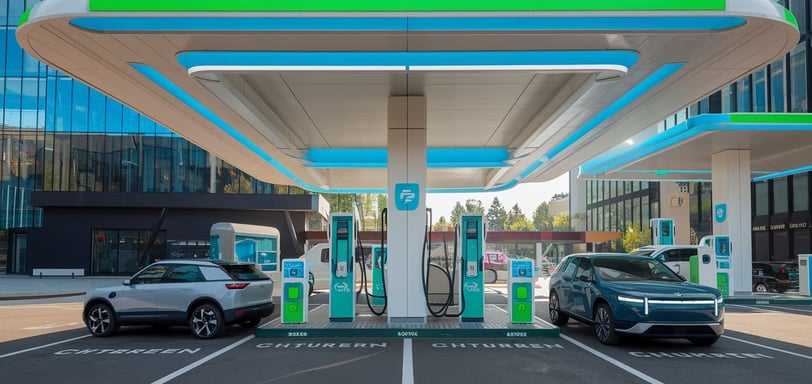Integrating EV Charging & Battery Swapping Benefits
Explore the transformative potential of integrating EV charging and battery swapping at petrol pumps and CNG stations. Learn about its numerous benefits, challenges, and a strategic blueprint to bring this innovative vision to life.
BLOG POSTEV CARD LATEST UPDATE EV FUTURE EVS NEWSDAILY INFO
evnovatech.com
1/5/20254 min read


"Revolutionizing the EV Landscape: Why Battery Swapping and Charging Stations Should Be at Every Petrol Pump and CNG Station!"
Electric vehicles (EVs) have transitioned from being a futuristic concept to a mainstream reality. As global societies embrace sustainable transportation, the urgency to establish comprehensive EV infrastructure becomes undeniable. Imagine pulling into a petrol pump or CNG station and seamlessly swapping your EV battery or charging it with ease—mirroring the simplicity of refueling conventional vehicles. This transformative vision is within reach. Below, we delve into the necessity, benefits, and practical implementation of this pivotal shift in mobility infrastructure.
The Imperative for EV Battery Swapping and Charging Infrastructure
1. The EV Renaissance
The global adoption of EVs is skyrocketing, buoyed by government incentives and heightened environmental awareness. However, a critical barrier remains: insufficient charging infrastructure. Lengthy charging times deter many potential users. Battery swapping—a solution where discharged batteries are replaced with fully charged ones in minutes—emerges as a revolutionary alternative.
2. Strategic Integration at Fuel Stations
Petrol pumps and CNG stations are ideally situated across urban and rural locales. Transforming these facilities into EV hubs would:
Maximize Existing Resources: Utilize the extensive network of fuel stations to reduce setup costs.
Enhance Accessibility: Ensure widespread availability of charging and swapping options, especially in underserved regions.
Catalyze Adoption: Alleviate range anxiety and encourage hesitant consumers to transition to EVs.
3. Accelerating Environmental Impact
By expediting EV adoption through accessible infrastructure, significant reductions in greenhouse gas emissions can be achieved, aligning with global climate objectives.
Battery Swapping: A Superior Alternative to Conventional Charging
Efficiency in Time
Traditional EV charging can range from 30 minutes to several hours. In contrast, battery swapping offers a sub-five-minute solution, akin to refueling a gasoline vehicle.
Minimized Operational Downtime
For commercial fleets, such as taxis and delivery services, prolonged charging times equate to revenue loss. Battery swapping ensures these vehicles remain operational with minimal interruption.
Economic Viability
By decoupling battery ownership from the vehicle, initial purchase costs are reduced. Moreover, this model simplifies battery maintenance and upgrades, fostering a more user-friendly ecosystem.
Optimized Energy Management
Centralized battery charging facilitates optimal charging conditions, extending battery life and efficiency. Additionally, these centers can prioritize renewable energy sources, further bolstering sustainability.
Challenges in Deployment
1. Standardization
A primary obstacle is the lack of uniformity in battery sizes and designs. Achieving industry-wide standardization is imperative for seamless implementation.
2. Capital Investment Requirements
The establishment of swapping stations and retrofitting of existing fuel stations demand significant upfront investment. Strategic public-private partnerships and targeted subsidies can alleviate these financial constraints.
3. Technological Complexities
Advanced robotic systems and automation are prerequisites for efficient battery swapping operations, adding layers of technological and financial complexity.
4. Ownership and Accountability
Shifting to a swapping model introduces questions around battery ownership, warranties, and liability for potential damages, necessitating robust regulatory frameworks.
Global Case Studies and Emerging Trends
China’s Pioneering Efforts
China has positioned itself as a leader in battery swapping, with companies like Nio establishing extensive networks of swapping stations. This initiative has garnered widespread consumer approval for its unparalleled convenience.
India’s Ambitious Outlook
India, with its aggressive EV adoption targets, has initiated pilot projects in major metropolitan areas. These programs underscore the feasibility of integrating battery swapping into the existing network of fuel stations.
A Strategic Roadmap for Transformation
Step 1: Feasibility Analysis
Conduct comprehensive studies to identify high-traffic petrol pumps and CNG stations suitable for EV infrastructure integration.
Step 2: Collaborative Partnerships
Foster alliances among energy corporations, EV manufacturers, and governmental entities to pool resources and expertise.
Step 3: Pilot Implementation
Launch pilot programs in densely populated urban centers to evaluate operational efficacy, user satisfaction, and scalability.
Step 4: Gradual Expansion
Leverage insights from pilot projects to extend infrastructure to suburban and rural regions.
Step 5: Emphasis on Standardization and Automation
Prioritize the development of standardized battery specifications and deploy advanced robotic systems to streamline swapping processes.
Why This Vision Resonates
Picture a scenario where you drive to a petrol pump during your daily commute and swap your EV battery in mere minutes. Such convenience dispels range anxiety and transforms EV ownership into a hassle-free experience. Fleet operators benefit from enhanced productivity and reduced operational costs, while society at large enjoys cleaner air and a sustainable future.
FAQ: Addressing Common Questions
Q1: What defines battery swapping?
Battery swapping involves replacing a depleted EV battery with a fully charged one, bypassing the need for prolonged charging times.
Q2: How does swapping differ from charging?
Unlike conventional charging, which replenishes a battery’s energy, swapping substitutes the entire battery, drastically reducing vehicle downtime.
Q3: Why integrate EV infrastructure into petrol pumps and CNG stations?
Fuel stations are strategically distributed and easily accessible. Their integration with EV infrastructure leverages existing networks to promote convenience and widespread adoption.
Q4: What are the primary challenges in battery swapping?
Key challenges include the lack of standardized battery designs, substantial initial investments, and battery ownership concerns. Collaborative innovation and policy support can address these issues.
Q5: Is battery swapping universally applicable?
Battery swapping is currently more feasible for smaller EVs and commercial fleets. However, ongoing technological advancements could make it viable for a broader range of vehicles.
Conclusion: Charting a Path Forward
Integrating EV battery swapping and charging infrastructure into petrol pumps and CNG stations represents a transformative step in sustainable mobility. By addressing implementation challenges through innovation and collaboration, this vision can become a tangible reality. The time to act is now—accelerating this transition will pave the way for a cleaner, more efficient transportation future.
Click-Bait Title:
"The EV Revolution Needs This! Why Every Petrol Pump and CNG Station Must Have Battery Swapping and Charging Stations!"
Image Prompt: A vibrant petrol pump featuring EVs engaged in seamless battery swaps and fast charging under a futuristic canopy, surrounded by a mix of traditional and electric vehicles.
Short Description: Explore the transformative potential of integrating EV charging and battery swapping at petrol pumps and CNG stations. Learn about its benefits, challenges, and a strategic blueprint to bring this vision to life.
